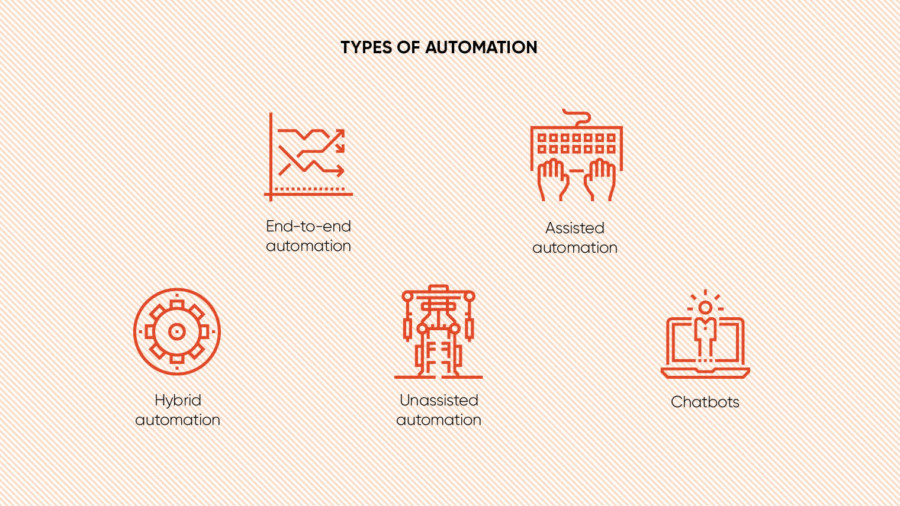Reconciling purchase orders and invoices, entering manual orders into order management systems, booking home visits for utilities or allocating inquiries to departments across an organisation are all simple processes that can be carried out by robots. Many businesses are experimenting with robotic process automation (RPA), an emerging form of automation technology which takes simple, repetitive and non-judgmental tasks out of the hands of humans and gives them to robots.
Many multinational companies and large organisations have carried out proofs of concept of RPA, dipping their toes in the water by running limited tests on two or three processes. This gives them a flavour of the huge possibilities for improved efficiency that RPA offers. But once the tests are finished and the results have come in, many businesses ponder how to move forward. Which processes should they automate first? What happens with tasks that can only be partially automated? How will automation change the way the business processes and indeed the way business works?
After the initial test phase, businesses need to take a holistic view of their operations and automation requirements. They must identify all the processes which lend themselves to automation, make the business case for automating them and estimate how this will impact the rest of the organisation. They need to consider how automation will affect channels such as e-mail, social media, chat and messaging.
Infosys and its product subsidiary EdgeVerve have developed considerable expertise in RPA and work in areas such as telecoms, retail, manufacturing, healthcare, finance and insurance
This stage of RPA involves carrying out time-and-motion studies of maybe 50 or 100 common processes in the business. This will reveal how many times those tasks are carried out each year, the average time they last and the benefits that will accrue from automating them.
This analysis can be achieved by working with consultants. Alternatively, businesses can use software tools, such as the AssistEdge Integrated Device Monitoring from Infosys. This plugs into the company’s IT systems to identify the work processes the business undertakes and collects data on them. It will then suggest a list of tasks to be automated and outline the benefits in time and costs saved.
Infosys and its product subsidiary EdgeVerve have developed considerable expertise in RPA and work in areas such as telecoms, retail, manufacturing, healthcare, finance and insurance.
Robin George, regional head of products and platforms at EdgeVerve, says: “We are working with several organisations across the globe on their RPA journey, starting with identifying manual tasks that help take ‘the robot out of the full-time worker’, jointly designing a holistic automation program that is enterprise ready and future-proof.
“Our approach, experience and product capabilities provides a realistic view of what benefits can be achieved through robots or ‘virtual full-time equivalents’, reduces the risk associated with the RPA program and provides a clear path to cognitive automation using Infosys Nia, the purposeful artificial intelligence platform.”
Before a full rollout of RPA can take place, the business needs to be “enterprise ready”. The organisation’s control and governance systems need to be in place, and ready to implement the automation. That means developing a plan for which departments will be responsible for implementation. Will the IT department lead or will an automation centre of excellence be established? How will the staff whose jobs are automated be redeployed across the business?

Being enterprise ready also means looking at process re-engineering, the scalability and security aspects of automation, managing automation changes in production, and preparing for artificial intelligence-led automation.
Making the case for automation requires a strategy that looks beyond simple cost reduction. RPA needs the backing of the whole organisation, so all stakeholders need to understand the wider benefits. These include avoiding extra costs from inefficient processes, for instance paying fines for poor quality service or non-compliance.
The strategy also needs to look at the revenue uplift which RPA can deliver. If the business can offer a product faster through automated processes, this will boost revenue. For example, if a broadband provider can initiate a service in a customer’s home a few days earlier than usual by automating parts of the process, it means extra days of rental income. Then there are other benefits that are hard to measure, such as improved customer service.
One of the great benefits of RPA is that it can be achieved without any change in the IT landscape of the organisation, so it is not intrusive. This means minimal disruption to IT and internal systems such as enterprise resource planning, billing, customer relationship management and other processes.
The costs required to carry out RPA are low and the benefits flow rapidly. A typical system re-engineering project may deliver benefits in 18 months. But RPA, when done well, will bring benefits within three months. Fast, effective and efficient, RPA is a route to building better businesses through automation.
For more information please visit www.edgeverve.com/assistedge/
